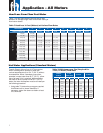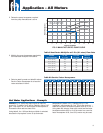
Application – All Motors
The primary purpose of grounding the metal drop pipe
and/or metal well casing in an installation is safety. It is
done to limit the voltage between nonelectrical (exposed
metal) parts of the system and ground, thus minimizing
dangerous shock hazards. Using wire at least the size of
the motor cable wires provides adequate current-carrying
capability for any ground fault that might occur. It also
provides a low resistance path to ground, ensuring that
the current to ground will be large enough to trip any
overcurrent device designed to detect faults (such as a
ground fault circuit interrupter, or GFCI).
Normally, the ground wire to the motor would provide the
Franklin Electric control boxes meet UL requirements for
NEMA Type 3R enclosures. They are suitable for indoor
and outdoor applications within temperatures of +14 °F
(-10 °C) to 122 °F (50 °C). Operating control boxes below
+14 °F can cause reduced starting torque and loss of
overload protection when overloads are located in
control boxes.
Control boxes and panels should never be mounted in
direct sunlight or high temperature locations. This will
cause shortened capacitor life and unnecessary tripping
Control Box and Panel Environment
of overload protectors. A ventilated enclosure painted
white to refl ect heat is recommended for an outdoor, high
temperature location.
A damp well pit, or other humid location, accelerates
component failure from corrosion.
Control boxes with voltage relays are designed for
vertical upright mounting only. Mounting in other
positions will affect the operation of the relay.
Allowable motor temperature is based on atmospheric
pressure or higher surrounding the motor. “Drawdown
seals,” which seal the well to the pump above its intake
Grounding Surge Arrestors
An above ground surge arrestor must be grounded,
metal to metal, all the way to the lowest draw down water
strata for the surge arrestor to be effective. GROUNDING
THE ARRESTOR TO THE SUPPLY GROUND OR TO
A DRIVEN GROUND ROD PROVIDES LITTLE OR NO
SURGE PROTECTION FOR THE MOTOR.
to maximize delivery, are not recommended, since the
suction created can be lower than atmospheric pressure.
Equipment Grounding
primary path back to the power supply ground for any
ground fault. There are conditions, however, where the
ground wire connection could become compromised.
One such example would be the case where the water
in the well is abnormally corrosive or aggressive. In this
example, a grounded metal drop pipe or casing would
then become the primary path to ground. However,
the many installations that now use plastic drop pipes
and/or casings require further steps to be taken for
safety purposes, so that the water column itself does not
become the conductive path to ground.
When an installation has abnormally corrosive water
AND the drop pipe or casing is plastic, Franklin Electric
recommends the use of a GFCI with a 10 mA set-point.
In this case, the motor ground wire should be routed
through the current-sensing device along with the motor
power leads. Wired this way, the GFCI will trip only when
a ground fault has occurred AND the motor ground wire
is no longer functional.
WARNING: Serious or fatal electrical shock may
result from failure to connect the motor, control
enclosures, metal plumbing and all other metal
near the motor or cable to the power supply ground
terminal using wire no smaller than motor cable wires.
WARNING: Failure to ground the control frame can
result in a serious or fatal electrical shock hazard.
The National Electrical Code requires that the control box
or panel-grounding terminal always be connected to supply
ground. If the circuit has no grounding conductor and no
metal conduit from the box to supply panel, use a wire at
least as large as line conductors and connect as required
by the National Electrical Code, from the grounding terminal
to the electrical supply ground.
Drawdown Seals
Grounding Control Boxes and Panels
9


















